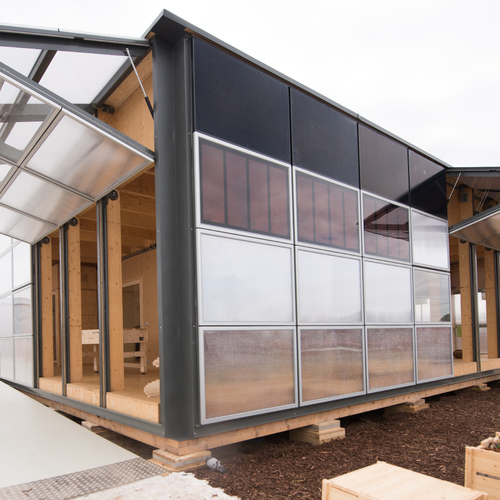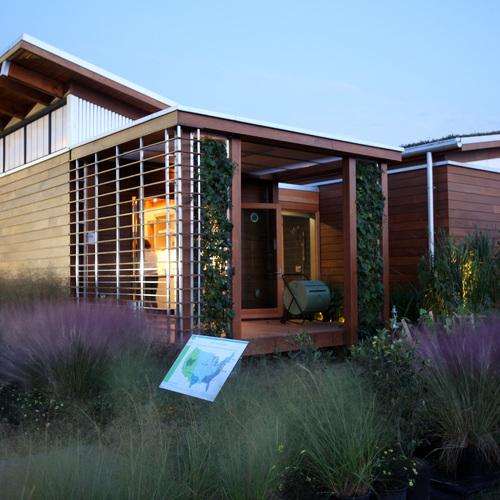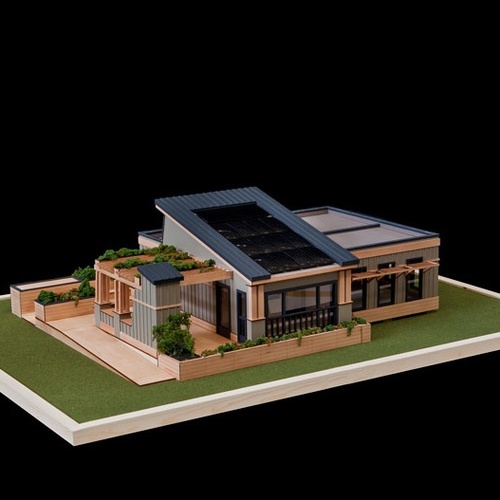
Image Credit: Solar Decathlon Europe (images 1, 3, 4, 8, and 9); Virginia Polytechnic Institute & State University (image 2, 5, 6, 7, and 10)
Image Credit: Solar Decathlon Europe (images 1, 3, 4, 8, and 9); Virginia Polytechnic Institute & State University (image 2, 5, 6, 7, and 10) Lumenhaus is designed to be transported without extensive dismantling, and it can be set up relatively quickly onsite. Even by the end of the day on Thursday last week, scores for the top five entries made the contest too close to call. The Lumenhaus system of sliding exterior-wall panels is designed accommodate almost any climate condition while allowing maximum natural illumination. Moveable interior walls enable occupants to configure the interior to suit their needs. This detail shows the of the exterior-wall sliding layers, each of which can be operated independently. One of the exterior-wall layers, a stainless steel panel with laser-cut circles and angled discs. It is part of what the Virginia Tech team calls the Eclipsis System of shading and insulation. The stainless panel holes and the angle of the discs are arranged according to a pattern generated by an algorithm that, the Virginia Tech team says, is intended to simulate solar eclipses when light passes through the screen. Virginia Tech’s scores through 6 of the 10 major competition categories. Scores for the remaining categories are on the next image. Virginia Tech’s scores for four of the 10 main judging categories. At Solar Decathlon Europe in Madrid: Lumenhaus is at center-right, with Universidad CEU Cardenal Herrera’s SMLhouse to its right and Stuttgart University of Applied Sciences’ Stuttgart Team house to the left. Arts et Métiers Paris Tech’s Napevomo House is at far left.
Lumenhaus, an energy efficiency project of Virginia Polytechnic Institute and State University, took a bow on GBA last year as a team of students and faculty from the school prepared it for the Solar Decathlon held in Washington, DC, in October 2009. Virginia Tech placed thirteenth among the 20 competitors in that contest, although team members headed home with valuable competition experience and ideas to improve Lumenhaus as they prepared it for Solar Decathlon Europe, held June 18 through 27 in Madrid.
The result: Virginia Tech took first place among the competition’s 17 entries.
Like the version showcased in Washington, the updated Lumenhaus constructed in Madrid is rectangular and retains the Bauhaus design inspired by Mies Van Der Rohe’s Farnsworth House, in Plano, Illinois. Also like last year’s edition, this Lumenhaus champions the concept of “responsive architecture,” which in this case is pegged to a system of independently operating sliding screens and moveable walls designed to maximize the structure’s adaptability to climate changes and the needs of the occupants.
A layered system
Two types of sliding panels on the shell of Lumenhaus function as part of what team members call the Eclipsis System. One type is a stainless steel sheet into which circles are cut by a laser. An algorithm was used to determine the cutout pattern, which is pegged to each panel’s location on the house. Many of the disc-shaped cutouts remain inside the circular holes in the screen and are fixed at specific angles to allow optimal illumination and privacy. The partially obscured circles create an “eclipse” effect is as the angle of the sun changes during the day.
The other part of Eclipsis is a system of translucent polycarbonate insulating panels filled with Nanogel aerogel, which during cold weather provides additional thermal resistance to the shell while still transmitting a significant amount of sunlight to the interior.
Beyond Eclipsis, the Lumenhaus exterior is equipped with sliding bug screens, sliding glass doors, and muslin curtains.
The top three
In fact, Lumenhaus architecture was a hit with Decathlon Europe judges, who awarded it the maximum score – 120 points – it that category. (There were 10 major categories in all, and only two others offered 120-point maximums: “appliance functionality” – which includes nine subcategories – and “sustainability.”) The second-place team, University of Applied Sciences Rosenheim, whose entry was called Ikaros, scored 96 points in the architecture competition, while third-place Stuttgart University of Applied Sciences, which presented the Stuttgart Team house, scored 84 points in that contest.
Overall scores for the top three, though, were close, with Virginia Tech earning 811.93 points, Rosenheim 810.96, and Stuttgart 807.49. Among these three, Stuttgart earned top scores in the “engineering and construction,” “solar systems and hot water,” and “sustainability” categories, while Rosenheim took the lead over Virginia Tech and Stuttgart in “comfort conditions” and “photovoltaic.”
Weekly Newsletter
Get building science and energy efficiency advice, plus special offers, in your inbox.















0 Comments
Log in or create an account to post a comment.
Sign up Log in